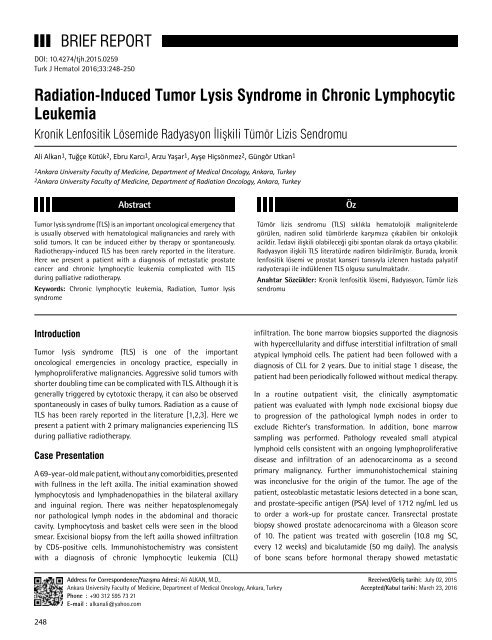Turkish Journal of Hematology Volume: 33 - Issue: 3
Create successful ePaper yourself
Turn your PDF publications into a flip-book with our unique Google optimized e-Paper software.
BRIEF REPORT<br />
DOI: 10.4274/tjh.2015.0259<br />
Turk J Hematol 2016;<strong>33</strong>:248-250<br />
Radiation-Induced Tumor Lysis Syndrome in Chronic Lymphocytic<br />
Leukemia<br />
Kronik Lenfositik Lösemide Radyasyon İlişkili Tümör Lizis Sendromu<br />
Ali Alkan 1 , Tuğçe Kütük 2 , Ebru Karcı 1 , Arzu Yaşar 1 , Ayşe Hiçsönmez 2 , Güngör Utkan 1<br />
1Ankara University Faculty <strong>of</strong> Medicine, Department <strong>of</strong> Medical Oncology, Ankara, Turkey<br />
2Ankara University Faculty <strong>of</strong> Medicine, Department <strong>of</strong> Radiation Oncology, Ankara, Turkey<br />
Abstract<br />
Tumor lysis syndrome (TLS) is an important oncological emergency that<br />
is usually observed with hematological malignancies and rarely with<br />
solid tumors. It can be induced either by therapy or spontaneously.<br />
Radiotherapy-induced TLS has been rarely reported in the literature.<br />
Here we present a patient with a diagnosis <strong>of</strong> metastatic prostate<br />
cancer and chronic lymphocytic leukemia complicated with TLS<br />
during palliative radiotherapy.<br />
Keywords: Chronic lymphocytic leukemia, Radiation, Tumor lysis<br />
syndrome<br />
Öz<br />
Tümör lizis sendromu (TLS) sıklıkla hematolojik malignitelerde<br />
görülen, nadiren solid tümörlerde karşımıza çıkabilen bir onkolojik<br />
acildir. Tedavi ilişkili olabileceği gibi spontan olarak da ortaya çıkabilir.<br />
Radyasyon ilişkili TLS literatürde nadiren bildirilmiştir. Burada, kronik<br />
lenfositik lösemi ve prostat kanseri tanısıyla izlenen hastada palyatif<br />
radyoterapi ile indüklenen TLS olgusu sunulmaktadır.<br />
Anahtar Sözcükler: Kronik lenfositik lösemi, Radyasyon, Tümör lizis<br />
sendromu<br />
Öz<br />
Introduction<br />
Tumor lysis syndrome (TLS) is one <strong>of</strong> the important<br />
oncological emergencies in oncology practice, especially in<br />
lymphoproliferative malignancies. Aggressive solid tumors with<br />
shorter doubling time can be complicated with TLS. Although it is<br />
generally triggered by cytotoxic therapy, it can also be observed<br />
spontaneously in cases <strong>of</strong> bulky tumors. Radiation as a cause <strong>of</strong><br />
TLS has been rarely reported in the literature [1,2,3]. Here we<br />
present a patient with 2 primary malignancies experiencing TLS<br />
during palliative radiotherapy.<br />
Case Presentation<br />
A 69-year-old male patient, without any comorbidities, presented<br />
with fullness in the left axilla. The initial examination showed<br />
lymphocytosis and lymphadenopathies in the bilateral axillary<br />
and inguinal region. There was neither hepatosplenomegaly<br />
nor pathological lymph nodes in the abdominal and thoracic<br />
cavity. Lymphocytosis and basket cells were seen in the blood<br />
smear. Excisional biopsy from the left axilla showed infiltration<br />
by CD5-positive cells. Immunohistochemistry was consistent<br />
with a diagnosis <strong>of</strong> chronic lymphocytic leukemia (CLL)<br />
infiltration. The bone marrow biopsies supported the diagnosis<br />
with hypercellularity and diffuse interstitial infiltration <strong>of</strong> small<br />
atypical lymphoid cells. The patient had been followed with a<br />
diagnosis <strong>of</strong> CLL for 2 years. Due to initial stage 1 disease, the<br />
patient had been periodically followed without medical therapy.<br />
In a routine outpatient visit, the clinically asymptomatic<br />
patient was evaluated with lymph node excisional biopsy due<br />
to progression <strong>of</strong> the pathological lymph nodes in order to<br />
exclude Richter’s transformation. In addition, bone marrow<br />
sampling was performed. Pathology revealed small atypical<br />
lymphoid cells consistent with an ongoing lymphoproliferative<br />
disease and infiltration <strong>of</strong> an adenocarcinoma as a second<br />
primary malignancy. Further immunohistochemical staining<br />
was inconclusive for the origin <strong>of</strong> the tumor. The age <strong>of</strong> the<br />
patient, osteoblastic metastatic lesions detected in a bone scan,<br />
and prostate-specific antigen (PSA) level <strong>of</strong> 1712 ng/mL led us<br />
to order a work-up for prostate cancer. Transrectal prostate<br />
biopsy showed prostate adenocarcinoma with a Gleason score<br />
<strong>of</strong> 10. The patient was treated with goserelin (10.8 mg SC,<br />
every 12 weeks) and bicalutamide (50 mg daily). The analysis<br />
<strong>of</strong> bone scans before hormonal therapy showed metastatic<br />
Address for Correspondence/Yazışma Adresi: Ali ALKAN, M.D.,<br />
Ankara University Faculty <strong>of</strong> Medicine, Department <strong>of</strong> Medical Oncology, Ankara, Turkey<br />
Phone : +90 312 595 73 21<br />
E-mail : alkanali@yahoo.com<br />
Received/Geliş tarihi: July 02, 2015<br />
Accepted/Kabul tarihi: March 23, 2016<br />
248

















